Effects pedals have changed not only guitar playing but music in general. These simple stompboxes have changed how musicians interact with their instruments and have added a layer of creativity to music. There is a lot to love about effects pedals, but with so many options on the market and different types of effects available, it is important to learn about pedals and how they function before you fill up your pedalboard.
So, let’s dive into my ultimate guide to effects pedals. Here, I aim to give you all the information you could possibly need on guitar effects pedals, as well as some of my favorite models.
Table of contents
- History of effects pedals
- Digital vs Analog
- True vs buffered bypass
- Different types of effects
- Tuner
- Gain effects
- Time based effects
- Modulation effects
- Frequency effects
- Other effects
- Pedal order
- Guitar effects with bass
- Choosing effects pedals
- Power your pedals
(Brief) history of effects pedals
Guitar effects pedals have been around for most of the 20th century, but they have transformed immensely in the last few decades. The first guitar effect pedal was the DeArmond tremolo pedal, created in the 1940s. It was bulky and difficult to use, so it didn’t really catch on with the mainstream and was only used in a few studio settings.
In the 1960s, effects pedals had their renaissance. They went from being large hefty devices to something that could fit in your guitar case. Keith Richards played a distortion pedal in 1965 on “(I Can’t Get No) Satisfaction”, opening the world to the world of glorious effects. In 1967, Jimi Hendrix jammed with a wah-wah and fuzz face. This shift from effects being a studio accessory to something anyone could use popularized them rapidly and pushed for new effects to be developed. This changed the course of music history as the new effects allowed musicians to experiment and create different sounds with their instruments.
Listen to this intro in which Keith Richards plays one of the first distortion pedals.
Digital vs. Analog Effects
The original effects pedals and most major effects today are analog. An analog pedal uses the authentic guitar tone, essentially copying the sound while tweaking certain things to change the tone, gain, etc. As a result, analog effects are generally considered better sounding and have a warmer tone than digital effects.
Digital effects change the guitar’s sound to a series of 1s and 0s, alter the code to add an effect, and then change it back to an analog signal and transfer it to the amplifier. Digital technology is improving, but the general consensus among guitarists is that digital effects do not live up to the sound quality of analog pedals.
Check out my article on this topic for more info on digital vs. analog effects.
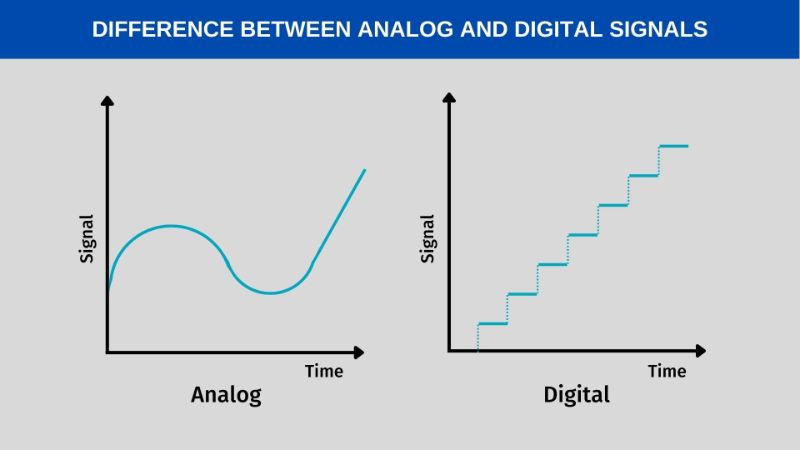
True bypass vs. buffered effect pedals
One thing you’ll see a lot of when scouring the web for effects pedals is buffered bypass and true bypass effects. This has to do with how the sound travels through the pedal’s circuits when the pedal is turned off.
With a true bypass pedal, the guitar’s signal passes straight through the pedal as if the pedal wasn’t there. These pedals preserve their tone but experience some issues, such as noise when turning the pedal on and tone issues when using longer cables.
With a buffered bypass pedal, your guitar’s signal passes through the circuit of the pedal even when the pedal is turned off. So while the pedal won’t affect the sound of your guitar, it will create a buffer between effects. While buffered effects do not have the best tone compared to true bypass effects, they solve a few issues with your gear setup, especially if you have lots of long cables.
Different types of effects
Here are all of the different kinds of effects pedals available and some of my top pedal recommendations.
Tuner
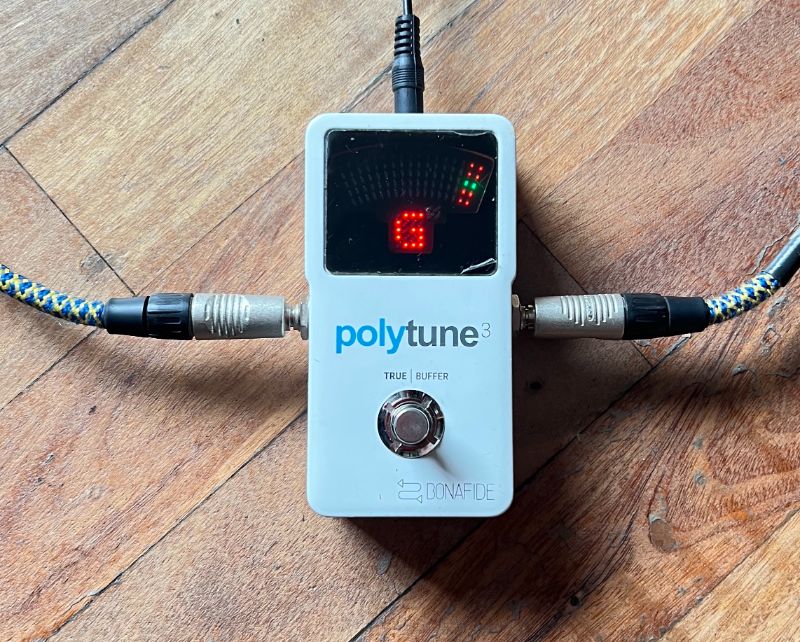
A tuner may not be the most exciting type of effects pedal. In fact, it doesn’t actually have much of an effect on your sound. But tuner pedals are a great place to start. This pedal allows you to quickly fix any pitch issues you may have. This comes in particularly useful in the middle of a performance if you notice any of your strings going out of tune.
Tuner pedals typically shut off the volume of your guitar automatically and are the easiest and most accurate way to tune your strings.
Lev’s picks: tuner pedals
Boss Chromatic Tuner
The Boss Chromatic Tuner is a staple in the guitar world. This tuner has all the bells and whistles you could need, and it is extremely accurate!
TC Electronic Polytune
This is a more compact tuner pedal than the Boss version, and it has a clear and bright display that makes tuning in brighter settings easier.
Gain effects
Gain ultimately determines how dirty your electric guitar’s tone is. In other words, more gain = more distortion. Distortion comes in three different flavors: overdrive, distortion, and fuzz. While these three effects are similar, they have a few key differences that make them ideal for different uses. Many guitarists often confuse the three. So, check out my guide for a more detailed comparison between these three pedals.
Overdrive
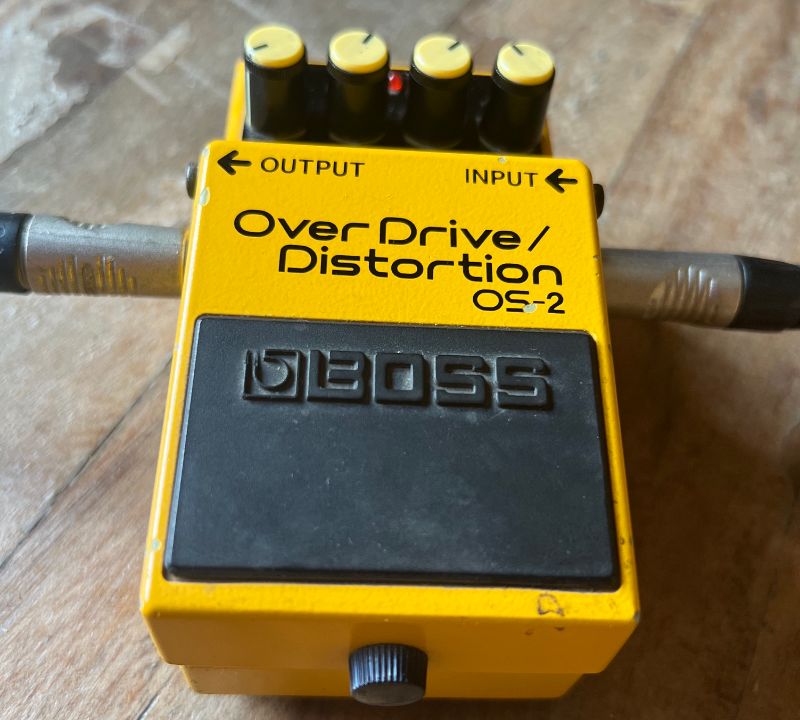
Overdrive is a distortion effect pedal that will add grit to your sound. This effect will generally start with a clean sound but will add crunch to your sound the harder you play. Many guitarists use overdrive pedals to emulate the sound of the iconic tube amp. This is one of the most popular pedals and is an excellent addition to guitarists that play blues, rock, or even hard rock and metal.
Lev’s pick: overdrive pedal
EarthQuaker Special Cranker
The Special Cranker is an overdrive pedal that keeps things simple while adding an awesome layer of crunch and sustain. In the end, you really don’t need a fancy digital overdrive pedal; something that provides a well-rounded tube amp sound is the perfect pedal in my opinion.
Distortion
Distortion pedal effects will make your guitar sound unrecognizable. This effect will give you a wide range of synthetic saturation that allows guitarists to cut through other noises – especially when it comes time for a stand-out solo. For this reason, this pedal is often used in heavier music, such as metal and hard rock.
Lev’s picks: distortion pedals
Boss DS-1
The Boss DS-1 is an iconic effect pedal that has been used by many different famous guitarists, including Kurt Cobain and Prince! It provides a versatile distortion sound that is clear and smooth.
Pro Co RAT
The RAT is another popular pedal that every electric guitarist has likely encountered at one point. The RAT pedal doesn’t cut any corners and is a simple baseline distortion you can’t go wrong with. The settings are easy to use, and it sounds crisp and smooth. A great many bands have used the RAT distortion pedal over the years, including Metallica, The Foo Fighters, and Slayer.
Fuzz
Fuzz is the most extreme of the distortion effects. It cuts out the tone you are playing by distorting it to the point where it sounds almost like white noise. This effect opens the gateway for guitarists to experiment with various sounds in their riffs and solos. Alternative and rock guitarists that want to experiment with intense distortion choose this effect pedal.
Lev’s pick: fuzz pedal
Jim Dunlop Fuzz Face
This is a reissue of the classic Jim Dunlop pedal that was used extensively in the 1960s. It provides the original “fuzzy” sound that attracted Jimi Hendrix to famously use it in many of his live performances and recordings.
Here is a demo video of what the Fuzz Face sounds like with different settings. You can tell how gritty and distorted the sound gets when you turn the Fuzz all the way up.
Time-based effects
Delay and reverb are two different guitar effects that manipulate the timing of your guitar’s sound. These two effects are easily confused, so check out my article outlining the difference between delay and reverb.
Delay
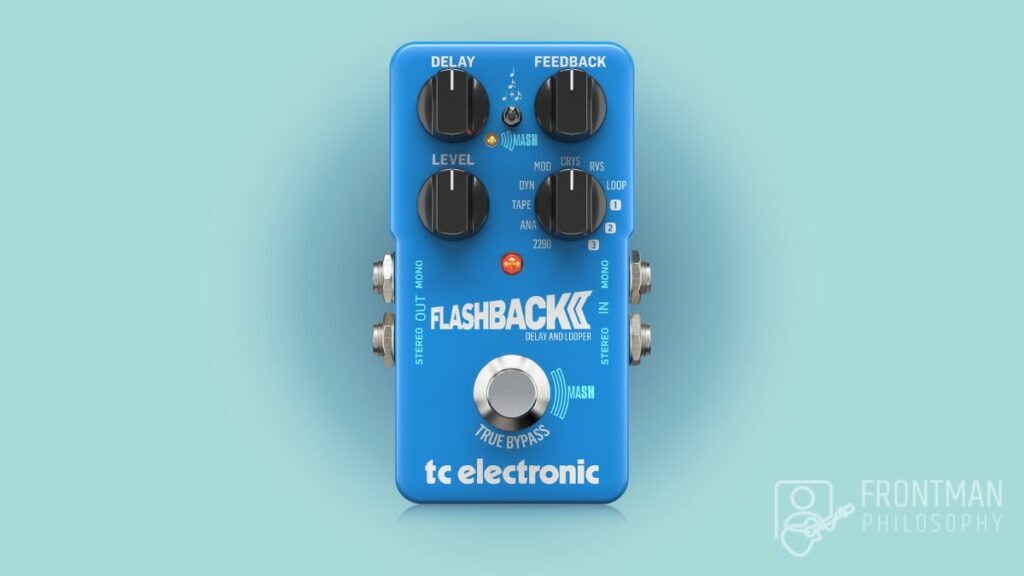
The basic function of a delay effect is simple: it plays back a signal at a later, or delayed, time. Delay effects pedals generally allow guitarists to choose the duration, volume, and intensity of the repeat, and they also allow control over the number of repeats. Despite their simplicity, delay pedals are one of the most versatile types of effects out there. They can be used in virtually all genres in all contexts.
Lev’s pick: delay pedal
TC Electronic Flashback 2
The TC Electronic Flashback 2 delay pedal is one of my personal favorites. This pedal has an unmatched amount of customization options and is just a great pedal overall. The “MASH” capability also allows you to control the intensity using the footswitch! For more information on this pedal, check out my review of the Flashback 2.
Reverb
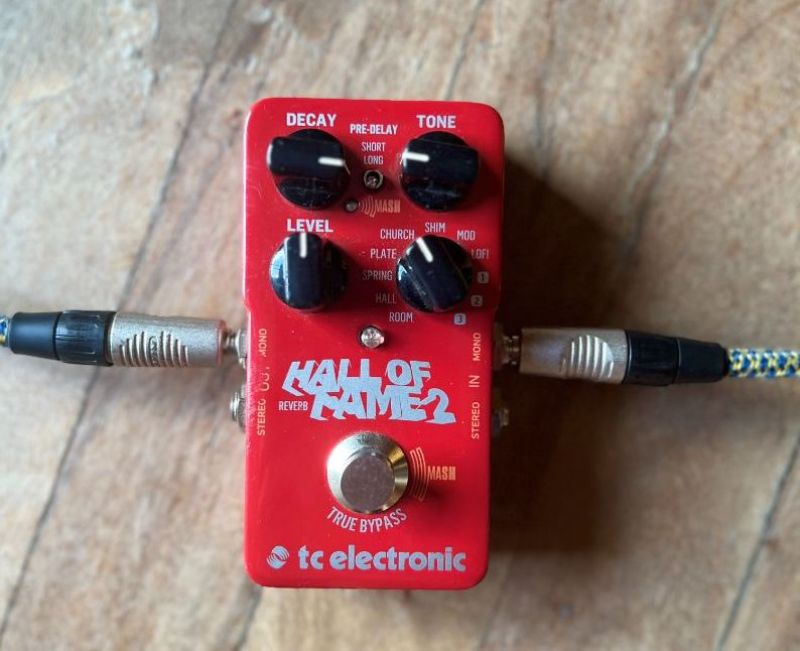
Reverb takes inspiration from the natural occurrence of sound bouncing off of walls. While these acoustic reflections can be natural, many guitarists use the reverb effect to create this sound synthetically. Reverb effects can generate a lot of depth and flavor in the sound by making guitarists sound as though they are playing in a large, open space – even when playing in a cramped bar.
Lev’s picks: reverb pedals
TC Electronic Hall Of Fame 2
The Hall Of Fame 2 is world-class reverb and awesome customization packed into one pedal. The pedal brings fantastic settings that will undoubtedly change how you use reverb. TC Electronic even allows you to customize your own settings and upload them to the pedal. I reviewed the pedal in depth in another article, so be sure to check that out.
EarthQuaker Dispatch Master
The EarthQuaker Dispatch Master is an interesting pedal because it combines reverb and delay into one device. While you may not get as many customization options for reverb as you do with the Hall Of Fame 2, having two pedals in one is definitely a win!
Modulation effects
Simply put, modulation effects change and move the notes you play up and down constantly in pitch or volume in varying ways.
Tremolo
Tremolo modulates the volume of your guitar. So as you play a note or chord, the volume tremors in an almost vibrating pattern. Tremolo was the first stand-alone guitar effect pedal in 1948 with the Trem Trol 800 Tremolo. Tremolo is a classic effect that is great for beginners because it doesn’t vary the sound too much and is super easy to use.
A great example of tremolo in a song is during Green Day’s opening riff of “Boulevard of Broken Dreams”.
Lev’s pick: tremolo pedal
Boss TR-2
The Boss TR-2 is an excellent tremolo pedal that allows you to control the effect’s depth, rate, and wavelength. This is one of the most popular tremolos because it is simple, effective, and will last a lifetime!
Vibrato
Vibrato pedals often get confused with tremolo pedals, but they have one main difference: vibrato uses a modulation effect that causes fluctuations in pitch, while tremolo modulates the volume. As the pitch goes higher and lower, a sense of rhythm is created, making the note that much richer in sound. Despite whammy bars being commonly referred to as “tremolo arms”, they actually have a vibrato effect. Vibrato pedals make it easier for guitarists to create the sound without shifting their fingers up and down or using a whammy bar.
Lev’s pick: vibrato pedal
MXR Uni-Vibe
This pedal has a classic 60s and 70s psychedelia sound and is similar to the pedals used by Jimi Hendrix and Pink Floyd. The pedal is actually a mix between a chorus effect and a vibrato, so it makes for some unique experimentation.
Flanger
Flangers are an interesting effect pedal that creates a “whooshing” effect by cloning the sound signal and adding a pulsing delay effect which manipulates the phase and timing of the wavelength.
Lev’s pick: flanger pedal
Boss BF-3
I know… another Boss pedal, but hear me out! The Boss BF-2 is an incredible device. The flanger effect is simple, but with the BF-3 you can manipulate the sound to match your vision exactly. You can control the EQ, depth range, depth center, resonance, and four different flanging modes with various intensities.
Phaser
Phaser pedals were created to emulate the sound of rotating organ speakers. This swirling effect was popularized by 1960s psychedelia. Since then, many iconic rock guitarists have used these pedals – including Van Halen. Phaser pedals are a modulation effect that creates an overall softer sound.
Lev’s pick: phaser pedal
MXR Phase 90
The Phase 90 is one of my favorite pedals. When I first started playing guitar, my Phase 90 and my Boss OS-2 were the only pedals I really used. Phasers sound similar to flangers with a spacier, more ethereal sound. This pedal has a surprising amount of versatility despite how small and simple it is. With only one dial, there aren’t too many bells and whistles, but the Phase 90 certainly does the trick!
Chorus
Last up for modulation effects is chorus. Chorus is undoubtedly the most popular modulation effect and was especially a staple effect in 80s rock. Chorus pedals add color and pitch modulation to any riff by doubling the source signal and coating it with a richer sound. In addition, guitarists can mess with the pitch parameter of the duplicated sound to create a more warbled effect. A classic example of the chorus effect is in Nirvana’s “Come As You Are”. Kurt Cobain used an Electro-Harmonix Small Clone pedal for the intro riff of this song.
Lev’s pick: chorus pedal
MXR Analog Chorus
The MXR Analog Chorus is a great effect that will give your guitar that classic 80s guitar sound. This effect pedal almost has an underwater effect. MXR hit the nail on the head with this pedal, so if you are looking for a reliable chorus pedal, this is the one for you!
Frequency Effects
Frequency effects affect just that: the frequency of your guitar’s tone. These effects allow you to boost, cut, or change the frequencies along the audio spectrum of your instrument.
Octave
The octave pedal is a frequency effect that makes the note played on the guitar higher or lower. These pedals can allow you to play an octave or two higher or lower, depending on what you are going for. You can also decide whether to keep the original note or forgo it altogether. Guitarists commonly use them to make their guitar sound more like a bass.
Lev’s pick: octave pedal
Boss OC-5 Octave
There are plenty of cheaper octave pedals out there, but if you want the most features and sound customization options, the Boss octave pedal is the way to go. You can go down to 2 octaves below the note and 1 octave above. The pedal also fuses the classic boss octave pedal sound with a “Poly” setting that allows for octaves on chords.
Pitch shifter
Pitch shifters create texture in the sound by creating harmonies. It works similarly to an octave pedal, but instead of playing the octave interval, the pitch shifter allows playing at several different intervals. This effect essentially allows a single note to become a chord.
Lev’s pick: pitch shifter pedal
DigiTech Drop
This is a great staple pitch shifter pedal. The DigiTech Drop is simple in design but does its job seamlessly. I love this pedal and have used it many times on my pedalboard over the years. When shifting your pitch, it has a warm natural tone that you don’t get with other options.
Other effects pedals
Here are a few other types of effects that you should get to know.
Wah-wah
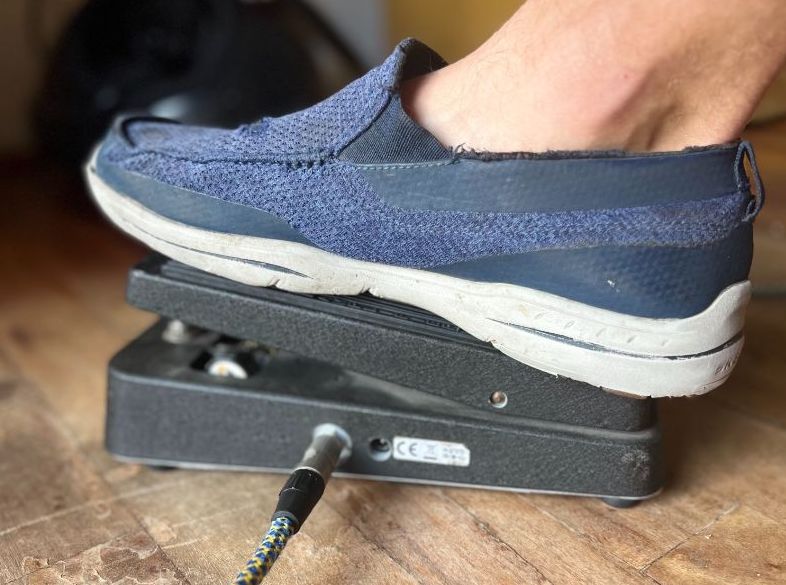
The wah-wah pedal is often used by rock guitarists and was made popular by Jimi Hendrix; it was one of the first effects to be popularized in the 1960s. Wah pedals alter the tone and frequency of your playing to create a wavy “wah sound”. This pedal is a staple in blues rock, rock, funk, psychedelic, and disco. This pedal creates that distinctive vocal-like wailing sound that can be incredibly fun to experiment with – especially when combined with other effects pedals.
Lev’s pick: wah-wah pedal
Dunlop Cry Baby Wah
No wah pedal lives up to the reputation of the glorious Cry Baby. Rock guitarists have used this pedal since the 1960s, and the newer models are fairly unchanged in terms of tone and settings. This is your best option if you are looking for a vintage wah pedal sound.
Check out my review of the Cry Baby Wah for more info on this classic pedal.
EQ
An EQ, or equalization, pedal allows guitarists to adjust the frequency output of a guitar. It can soften the noise by getting rid of harsh, unwanted sounds while focusing on the frequencies that you want to draw attention to. The EQ pedal is not only used to tailor the output, but some guitarists also use it for experimentation.
Lev’s pick: EQ pedal
Boss EQ-200
This EQ pedal is the cream of the crop. It has 10 different bands to adjust the EQ of your guitar, and you can store over 100 different settings. You can choose to use one of the 128 pre-saved EQ settings or adjust the bands to create your own. It is an absolute home run of an EQ pedal that I recommend every serious guitarist to have on their pedalboard.
Compression
Compressor effects will make the sound much cleaner by reducing the distance between the loudest and the quietest points of your guitar. In other words, whether you play loudly or softly, the compressor will adjust it so that the volume remains consistent. Guitarists can choose the ratio so that the volume range changes as much or as little as is fitting. If the ratio is reduced significantly, the sound will appear much less natural as there is less dynamic sound.
Lev’s pick: compression pedal
Keeley Compressor Plus
The Keeley Compressor Plus is a premium compression pedal with some seriously awesome features. You can switch between single coil and humbucker pickup modes, and there is a blend knob and a tone knob that allows you to adjust your sound to perfectly match what you are looking for.
Looper
A loop pedal is a great tool, particularly for solo guitarists looking to play their own accompaniment. This pedal allows you to create backing tracks in real time and build on layers on layers. Ed Sheeran is one of the most famous examples of musicians using loop pedals.
Lev’s pick: looper pedal
Boss RC-500 Loop Station
This is one of the best-quality looper pedals out there. The Boss RC-500 is your best option if you are looking for serious creative power. You can plug four instruments into the loop pedal, including a midi keyboard and a microphone. This loop station also has several preset drum and rhythm parts and is honestly pretty intuitive considering how powerful of a machine it is.
Check out my article, where I review the Boss RC-500 loop pedal in depth.
Multi-effects pedals
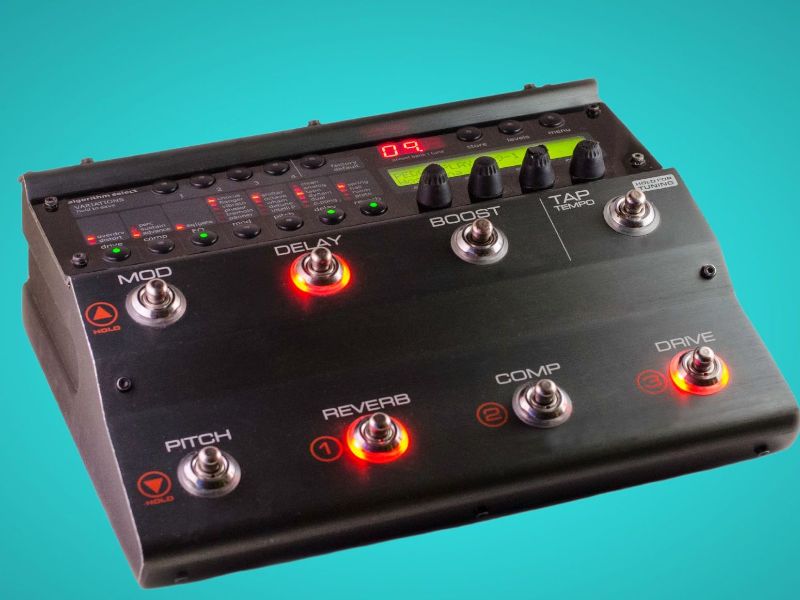
As the name suggests, multi-effects pedals are incredibly varied units that combine several guitar effects. These digital pedals allow you to access many different types of effects in just one unit, so having one will definitely save a lot of space! Multi-effects pedals can be as simple or as intricate as necessary. The cheaper models will often cover just the basic effects, while the more complex models may even allow you to make your own custom effects.
Lev’s pick: multi-effects pedal
Line 6 HX Effects Pedal
This is a great-sounding multi-effects pedal. Most digital effects don’t sound very authentic, but the tone of this pedal is good enough to turn an analog purist’s head. With 6 different effect slots as well as a 7th for a tuner, you will definitely get a lot out of this multi-effects unit. And it comes at a much more reasonable price than some other premium multi-effects options.
Pedal order
The order you should put your effects pedals is a hotly debated topic. But here are some golden rules I follow when placing effects on a pedalboard sequence.
- Volume pedals should be placed at either the beginning of the sequence to control the input volume or at the end to control the affected output volume.
- EQ or wah pedals should sit close to the beginning of the chain.
- Delay, reverb, and echo should be placed near the end of the pedal sequence.
- Modulation pedals should sit around the middle of the signal chain.
- Tuner pedals should always be placed first so that no effect interferes with the sound.
I suggest placing your pedals in this order: tuner, volume, compressor, wah-wah, overdrive/distortion, modulation (phaser or chorus), delay/reverb, and finally, looper.
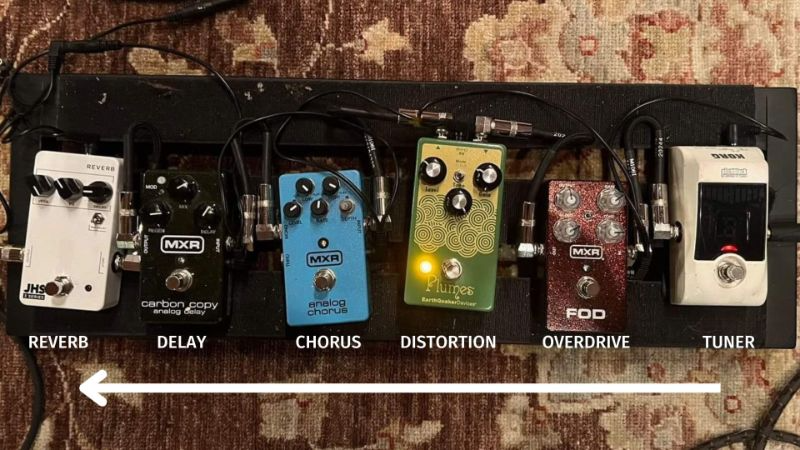
Using guitar effects pedals for bass
I get this question a lot. Can you use guitar effects for bass? In short, yes, you can.
You won’t damage your pedals or your bass by playing through guitar pedals. However, they will sound different, and depending on the effect pedal you use, you may not get the sound you are looking for. There are certain manufacturers that produce specific effects curated for bass frequencies. Since guitar effects are designed for guitar mid-range frequencies, effects like distortion, octave pedals, and overdrive will sound strange coming through a bass.
So if you are a bassist, consider looking for bass-specific pedals.
How to choose the best pedals
Guitarists nowadays are spoiled for choice when it comes to effects pedals. There are now hundreds of options for each type of effect, so finding the pedal best suits your needs and wants can be challenging. So here are my top tips for finding the best pedals for you.
Decide what kind of effects you want to use
No guitarist needs to have 20 effects pedals on their chain. Decide which effects make the most sense for your playing style and narrow down to 3-7 effects that you want to get.
Go to a music store and sample some effects
Go to your local music store or Guitar Center and ask to try out some effects. It is a good idea to bring your own guitar and amp so that you can hear what the pedal will sound like coming out of your setup.
Ask experts
Ask your guitar teacher, guitar technician, or salesperson about which effects you should use and what models will fit your style.
Read reviews
Once you have started narrowing down the type of pedals you want, read online reviews about the pedals and see what other similar musicians are recommending.
Powering your pedals
The final thing I will go over in this article is your power supply. Pedals need electricity to run. This means batteries or plugging them into a power supply somehow. Battery-run pedals are not a great option because they drain quickly, and changing your batteries will be expensive over time. Plugging your pedals into a power outlet using an ac adaptor is a good method, but if you have multiple pedals, it can get complicated to find power chords or use a power chord splitter to plug multiple chords into one port.
The best option is to use a power supply brick that allows you to plug multiple pedals into one device that is then plugged into a power outlet. These are much more efficient at powering your pedals, and they reduce voltage buzzing noises that can occur when plugging pedals into power sources.
I recommend the MXR Iso-Brick Power Supply. This power brick can power up to 10 pedals and is reasonably priced.
Wrapping up
Effects pedals are a great way to expand your guitar’s tone range and experiment with tons of different sounds. But navigating the huge amount of effects pedals out there can definitely be intimidating. My best advice? Start slow, build your pedalboard slowly, and learn what kind of effects you like. Don’t rush into having 30 different pedal options; start by buying 1-2 amazing pedals that you will use all the time.
Have any more questions about effects pedals, guitars, amps, basses, or anything else music related? Feel free to contact me. I am always happy to help!





